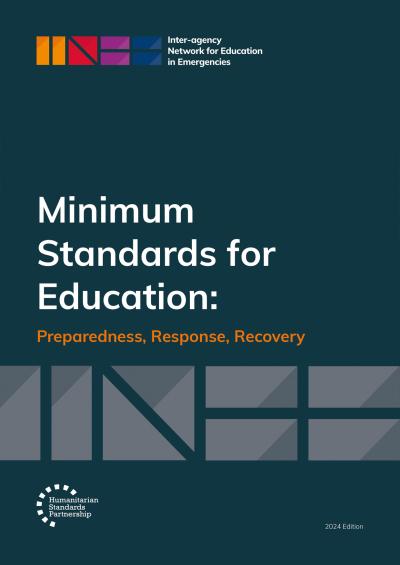Requisitos Mínimos da INEE, edição de 2024
Agradecemos o acesso à versão digital dos Requisitos Mínimos da INEE, edição de 2024. A versão em língua portuguesa da edição atualizada dos RMs da INEE ainda não está disponível. Para visualizar a edição de 2010 em português, clique aqui.
Os Requisitos Mínimos da INEE para a Educação: Preparação, Resposta e Recuperação (RM da INEE) trazem 19 Requisitos, cada um dos quais inclui Ações-Chave e Notas de Orientação. O objetivo dos Requisitos Mínimos da INEE é melhorar a qualidade da preparação, da resposta e da recuperação da educação; aumentar o acesso a oportunidades de aprendizagem seguras e relevantes; e garantir que agentes que oferecem esses serviços sejam responsabilizados. Os RM da INEE foram desenvolvidos para serem aplicáveis à resposta a crises em muitas situações diferentes, incluindo emergências causadas por conflitos; por riscos naturais, como os induzidos pelas mudanças climáticas; e crises de início lento e rápido, tanto em ambientes rurais quanto urbanos.

Domain 1: Foundational Standards for a Quality Response
Standard 1: Participation
Community members participate meaningfully, transparently, and without discrimination in the analysis, planning, design, implementation, monitoring, and evaluation of the education response.
Standard 2: Resources
Community resources are identified, mobilized, and used to implement age-appropriate learning opportunities.
Standard 3: Coordination
Education coordination mechanisms are in place to support the stakeholders who are working to ensure access to and continuity of quality education.
Standard 4: Assessment
Timely education assessments of the emergency situation are holistic, transparent, and participatory.
Standard 5: Response Strategies
Inclusive education response strategies include a clear description of the context and of the barriers to the right to education, and strategies to overcome those barriers.
Standard 6: Monitoring
There is regular monitoring of education response activities and of the evolving learning needs of the people affected.
Standard 7: Evaluation
Systematic and impartial evaluations improve education response activities and enhance accountability.
Domain 2: Access and Learning Environment
Standard 8: Equal and Equitable Access
All individuals have access to quality and relevant education opportunities.
Standard 9: Protection and Wellbeing
Learning environments are secure and safe, and they promote the protection and the psychosocial wellbeing of learners and teachers and other education personnel.
Standard 10: Facilities and Services
Education facilities promote the safety and wellbeing of learners and teachers and other education personnel, and are linked to health, nutrition, psychosocial, and protection services.
Domain 3: Teaching and Learning
Standard 11: Curricula
The curricula used to provide formal and non-formal education are culturally, socially, and linguistically relevant, and appropriate to the context and learner’s needs.
Standard 12: Teaching and Learning Processes
Teaching and learning processes are learner centered, participatory, and inclusive.
Standard 13: Assessment of Holistic Learning Outcomes
Appropriate methods are used to evaluate and validate holistic learning outcomes.
Standard 14: Training, Professional Development, and Support
Teachers and other education personnel receive regular, relevant, and structured training in line with their needs and circumstances.
Domain 4: Teachers and Other Education Personnel
Standard 15: Recruitment and Selection
A sufficient number of appropriately qualified teachers and other education personnel are recruited through a transparent and fair process, based on selection criteria reflecting diversity and equity.
Standard 16: Conditions of Work
Teachers and other education personnel have clearly defined conditions of work and receive appropriate compensation.
Standard 17: Support and Supervision
The support and supervision mechanisms in place for teachers and other education personnel function effectively.
Domain 5: Education Policy
Standard 18: Law and Policy Formulation
Education authorities prioritize the continuity and recovery of quality education, including free and inclusive access to learning.
Standard 19: Planning and Implementation
Education programs and activities reflect international and national educational policies, laws, standards, plans, and the learning needs of the people affected.




